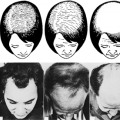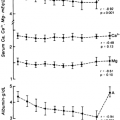HYPOTHALAMIC NEOPLASMS
GERMINOMA
Germinomas typically arise in the floor of the third ventricle and have a propensity to invade and compress adjacent neural structures, such as the optic chiasm, or to spread in the periventricular space, which permits craniospinal seeding. Although germinomas are the most common embryonal cell tumors, choriocarcinoma, endodermal sinus tumors, and teratomas may also occur at this site. The initial intervention for tumors arising in the floor of the third ventricle is often surgical. Surgery is indicated for diagnosis and to decompress the ventricles or to relieve pressure on the chiasm or the pituitary stalk. The rare teratomas in this location are amenable to surgical cure.
Current staging recommendations include contrast-enhanced magnetic resonance imaging (MRI) of the entire craniospinal axis. The incidence of spinal seeding varies and is often a function of the thoroughness of the investigation. The author recommends the use of triple-strength contrast during spinal imaging to assist in the detection of seeding of the leptomeninges or the cauda equina. Cerebrospinal fluid and serum evaluation for α-fetoprotein and the β-subunit of human chorionic gonadotropin (β-hCG) are recommended. Endodermal sinus tumors and, to a lesser extent, embryonal carcinomas cause elevations of α-fetoprotein; choriocarcinomas cause elevations of β-hCG. If either marker is elevated, repeat levels should be obtained postoperatively, after allowing time for the markers to decline. These markers allow monitoring of the treatment and follow-up phases.
Historically, the standard management of germinomas has consisted of craniospinal irradiation. So dramatic is the response of these tumors to radiation therapy that some researchers recommended a low test dose of limitedfield irradiation (to ˜20 Gy) as a diagnostic test in place of a biopsy.49 This practice is supported by a report that surgery is associated with a 41% incidence of spinal dissemination compared with a rate of only 2% in nonbiopsied patients.50 Although the issues of total dose and whether the spinal axis should be prophylactically radiated remain controversial, the overall disease-free survival rate for patients with germinoma is usually in excess of 80%.51 Of all patients with confirmed intracranial germ-cell tumors treated at the Hospital of Sick Children from 1952 to 1989, 25 patients with germinoma treated with radiotherapy had a 5-year survival rate of 85%, and 13 patients with nongerminoma germ-cell tumors treated with radiotherapy had a 5-year survival rate of 45.5%.52
The efficacy of chemotherapy for treatment of germ-cell neoplasms in other body sites has led to similar trials for intracranial germ-cell tumors. Preliminary results for treatment with platinum-based combination chemotherapy for 10 patients with intracranial germ-cell tumors are encouraging. Sevenpatients received primary chemotherapy consisting of vincristine, etoposide, and carboplatin before craniospinal axis irradiation; 3 patients had complete responses, 3 had partial responses, and 1 patient had stable disease. All 7 patients were alive and disease free at a median of 12 months after treatment. The author’s treatment for germinomas, attaining complete
response after two courses of chemotherapy, is a lowered radiation dose prescription, but nongerminomatous germ-cell tumors receive standard total dose irradiation.53
response after two courses of chemotherapy, is a lowered radiation dose prescription, but nongerminomatous germ-cell tumors receive standard total dose irradiation.53
Stay updated, free articles. Join our Telegram channel

Full access? Get Clinical Tree





